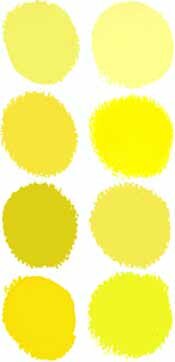Saltbox
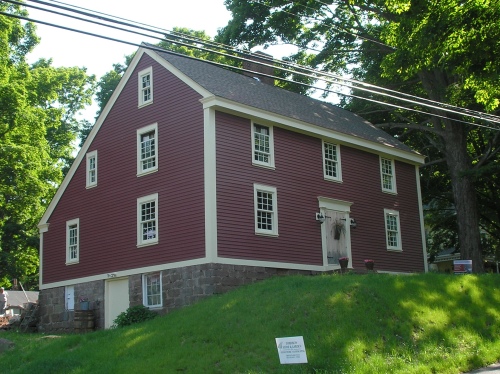
The saltbox style house is mainly characterized by its saltbox roof. It got its name because of its resemblance to old fashioned saltboxes. The windows are long and tall, designed to face South to capture the sun and its warmth, white the longer part of the roof is made to face the North so it catches the wind.
Garrison

The Garrison style house is the "Plain Jane" of colonial timed houses. It have very little decorative details, and long, narrow clapboard. The biggest identifier for this house is how the second story overhangs the first, and usually in the front.
Georgian

The Georgian Colonial Revival was named for King George. These houses have classic details around the doors, such as a fanlight. They are always appear symmetrical and and often give of a feeling of order. Some of the houses have wood siding (as pictured above), but most are made of brick.
Federal

These houses are somewhat similar to Georgian houses, as that they have classic details such as palladian windows, columns, and are symmetrical buildings. The lower level windows are often bigger or taller than the upper levels. The roof of this style of house is low-pitched and often disappears.
Greek Revival

This style of house is crafted to look like ancient Greek or Roman buildings. The White House has this style because is conveys the beliefs of the ancient cultures. Other buildings this can be found en are banks and libraries. There house are always either brick, or white clapboard. The sport classical details such as porticoes, pillars, pediments, and more. These are formal houses, with symetry, and give off the feel of authority.
Cape Cod

The Cape Cod is the smallest of the Colonial Revivals. It also often show symmetry, and has small pillars and a classical pediment. Most of these houses have dormers, but some do not. Originally, they were sided with wood shingles, but now they are most often sided with wooden clapboard.
Gothic Revival
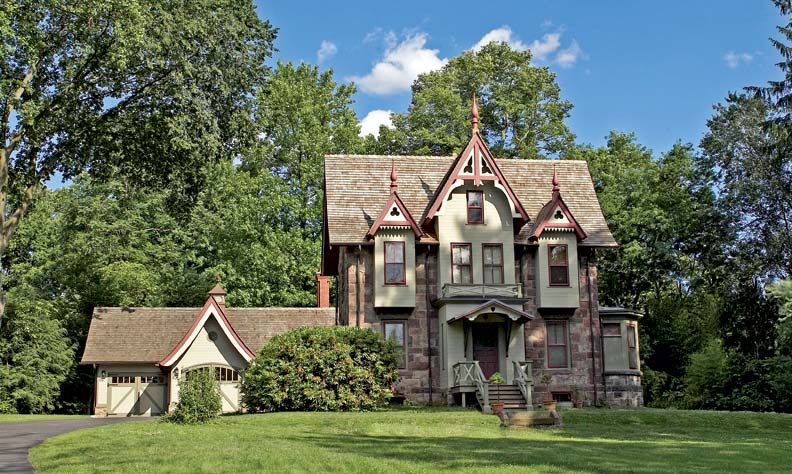
Not very popular in today's society, Gothic Revivals were built in the nineteenth century to be modeled after medieval Gothic cathedrals. They borrow characteristics such as pointed arches, high-pitched roofs, elaborate decorative trim, and towers.
Row House

Row houses are built on long, narrow properties close together which caused them be built UP rather than OUT. The walls of each house are set against each other, and the fronts often resemble each other. These houses are popular in high populated areas.
Italian Villa

Italian Villas can take many shapes and forms, but have a few key features which they all share. Classic columns, round arches, and pediments are common features. On the corners they have Quoins, which are stones stacked up in varying sizes.
Stick Style

These houses become popular during the industrial revolution when the jig saw was invented. This allows builders to create many intricate and individual wood decorations. Porches, windows and eves all possess this wood work, and it is this style of home's distinguishing feature.
Art Nouveau

Art Nouveau is much more decorative than most houses. There are often human faces wearing fancy headdresses, plants and flowers through out the decorations. Many of these designs are made with cement or stucco. Another popular form is stained glass windows.
Queen Anne

While many Queen Annes today are painted white, many of the originals were multicolored. Also know as a "ginger bread" house, they have large, sweeping porches and often towers or turrets. Like the Stick houses, they often have very detailed wood work on porches, windows and sometimes patterned wood shingles. They can be described as being romantic and article.

While many Queen Annes today are painted white, many of the originals were multicolored. Also know as a "ginger bread" house, they have large, sweeping porches and often towers or turrets. Like the Stick houses, they often have very detailed wood work on porches, windows and sometimes patterned wood shingles. They can be described as being romantic and article.
Tudor

Tudors always have a few staple design features such as, brick on the bottom, and white stucco in the top. They are also know for their dark, wood timbers and steep gable roofs. They will often have a fire place visible at he front or side of the house. When inscribed, they are considered romantic, dignified, and comfortable.

Tudors always have a few staple design features such as, brick on the bottom, and white stucco in the top. They are also know for their dark, wood timbers and steep gable roofs. They will often have a fire place visible at he front or side of the house. When inscribed, they are considered romantic, dignified, and comfortable.
Dutch

The most distinguishing feature of this style house is its gambrel roof. Like other colonials, it always has symmetry, one side mirroring the other. Other popular features include dormers and pediments.

The most distinguishing feature of this style house is its gambrel roof. Like other colonials, it always has symmetry, one side mirroring the other. Other popular features include dormers and pediments.
Spanish

The Spanish style is very unique in that is is made of poured cement or a stucco, and has clay shingles on the roof. There are no other real set features other than the general "Spanish style."

The Spanish style is very unique in that is is made of poured cement or a stucco, and has clay shingles on the roof. There are no other real set features other than the general "Spanish style."
Prairie

This style was created by Frank Lloyd Wright around 1901. It has low, long lines, open balconies, and long spreads of windows.This is made to reflect the the flat, open environment of the prairie. This natural feel also gives off the feeling of protection or shelter. Mainly found in the Midwest, these "organic houses" are very simplistic.

This style was created by Frank Lloyd Wright around 1901. It has low, long lines, open balconies, and long spreads of windows.This is made to reflect the the flat, open environment of the prairie. This natural feel also gives off the feeling of protection or shelter. Mainly found in the Midwest, these "organic houses" are very simplistic.
Ranch

The ranch house is always only one story high. They are very popular because they were the first houses to have an attached garage (previous house would have detached carriage houses).They often have small front porches, large front lawns, picture windows, shutters, and patios in the back yard.

The ranch house is always only one story high. They are very popular because they were the first houses to have an attached garage (previous house would have detached carriage houses).They often have small front porches, large front lawns, picture windows, shutters, and patios in the back yard.

The international style is pretty unique looking. It is commonly made of concrete, glass, and steel. It is slightly cold feeling, and is most commonly seen in commercial buildings.They are simple, contemporary, geometric buildings taking on the "less is more" attitude.
Split Level

Split level homes are very common in this area. They were first built in the 20th century, designed for houses on uneven land. The main floor is not on the same level as the front door, so you must either step up or step down to get it it.

Split level homes are very common in this area. They were first built in the 20th century, designed for houses on uneven land. The main floor is not on the same level as the front door, so you must either step up or step down to get it it.
Rustic

The rustic house is characterized by the feeling feeling it gives off more so than the design. They give off an outdoorsy, woodsy home. These are commonly seen as cabins, or vacation homes. They often has stone, and wood on the exterior.

The rustic house is characterized by the feeling feeling it gives off more so than the design. They give off an outdoorsy, woodsy home. These are commonly seen as cabins, or vacation homes. They often has stone, and wood on the exterior.
Chalet or Alpine

This style began as a Swiss mountain cottage, but later adopted the term alpine to describe it. It features long, over hanging eaves, and wood siding. It often includes a large deck. However, this style can vary from region to region.

This style began as a Swiss mountain cottage, but later adopted the term alpine to describe it. It features long, over hanging eaves, and wood siding. It often includes a large deck. However, this style can vary from region to region.
A-Frame

The A-frame gained popularity in the 50s as a vacation home or cabin in the US and Canada. It has a steeped pitched roof, which also serves as two of the side walls. This simplistic design was inexpensive to build. Over the years, this style has been incorporated in to other styles (Such as the Chalet) to expand and make it more elaborate.

The A-frame gained popularity in the 50s as a vacation home or cabin in the US and Canada. It has a steeped pitched roof, which also serves as two of the side walls. This simplistic design was inexpensive to build. Over the years, this style has been incorporated in to other styles (Such as the Chalet) to expand and make it more elaborate.
Dome

This is a very unique style, not seen very often. They are made of light, but strong triangular panels, arranged to create the dome shape. These were mainly used in the 50s for military and and industrial purposes. These buildings are economical and easy to build.

This is a very unique style, not seen very often. They are made of light, but strong triangular panels, arranged to create the dome shape. These were mainly used in the 50s for military and and industrial purposes. These buildings are economical and easy to build.
Solar
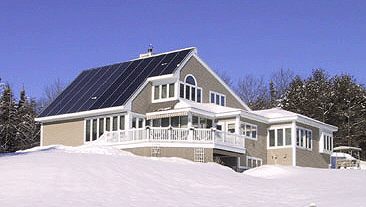
Solar houses are extremely efficient, and designed to work well with nature. There are two types, Active Solar, and Passive Solar. The former has panels titled toward the sun, to absorbed it energy and convert that in heat. The latter doesn't involve machinery, but they uses features such as south-facing windows, shading devices, double-pane windows, thick insulation, and heat absorbing masonry elements.

Solar houses are extremely efficient, and designed to work well with nature. There are two types, Active Solar, and Passive Solar. The former has panels titled toward the sun, to absorbed it energy and convert that in heat. The latter doesn't involve machinery, but they uses features such as south-facing windows, shading devices, double-pane windows, thick insulation, and heat absorbing masonry elements.
Earth Sheltered

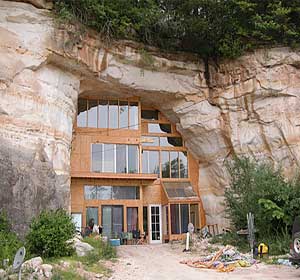
Earth sheltered homes are literally built into the earth (please enjoy this hobbit house). The beginning of this style traces back to the first human shelters which were caves. They are most often lined with soil on the back and sides, but sometimes the roof is also covered. These homes conserve energy and has some similar features to the Solar houses such as south-facing windows. These houses usually has a low, narrow shape, and are designed to be simple and practical. Their build possess clean lines lines and modern materials like concrete.


Earth sheltered homes are literally built into the earth (please enjoy this hobbit house). The beginning of this style traces back to the first human shelters which were caves. They are most often lined with soil on the back and sides, but sometimes the roof is also covered. These homes conserve energy and has some similar features to the Solar houses such as south-facing windows. These houses usually has a low, narrow shape, and are designed to be simple and practical. Their build possess clean lines lines and modern materials like concrete.
Manufactured
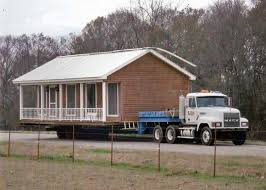
This style of house is build, sometimes entirely, in a factory. They are transported but truck to the building site where they are assembled. The benefits of this house include lower costs, and shorter construction times.
This style of house is build, sometimes entirely, in a factory. They are transported but truck to the building site where they are assembled. The benefits of this house include lower costs, and shorter construction times.
Mobile Home
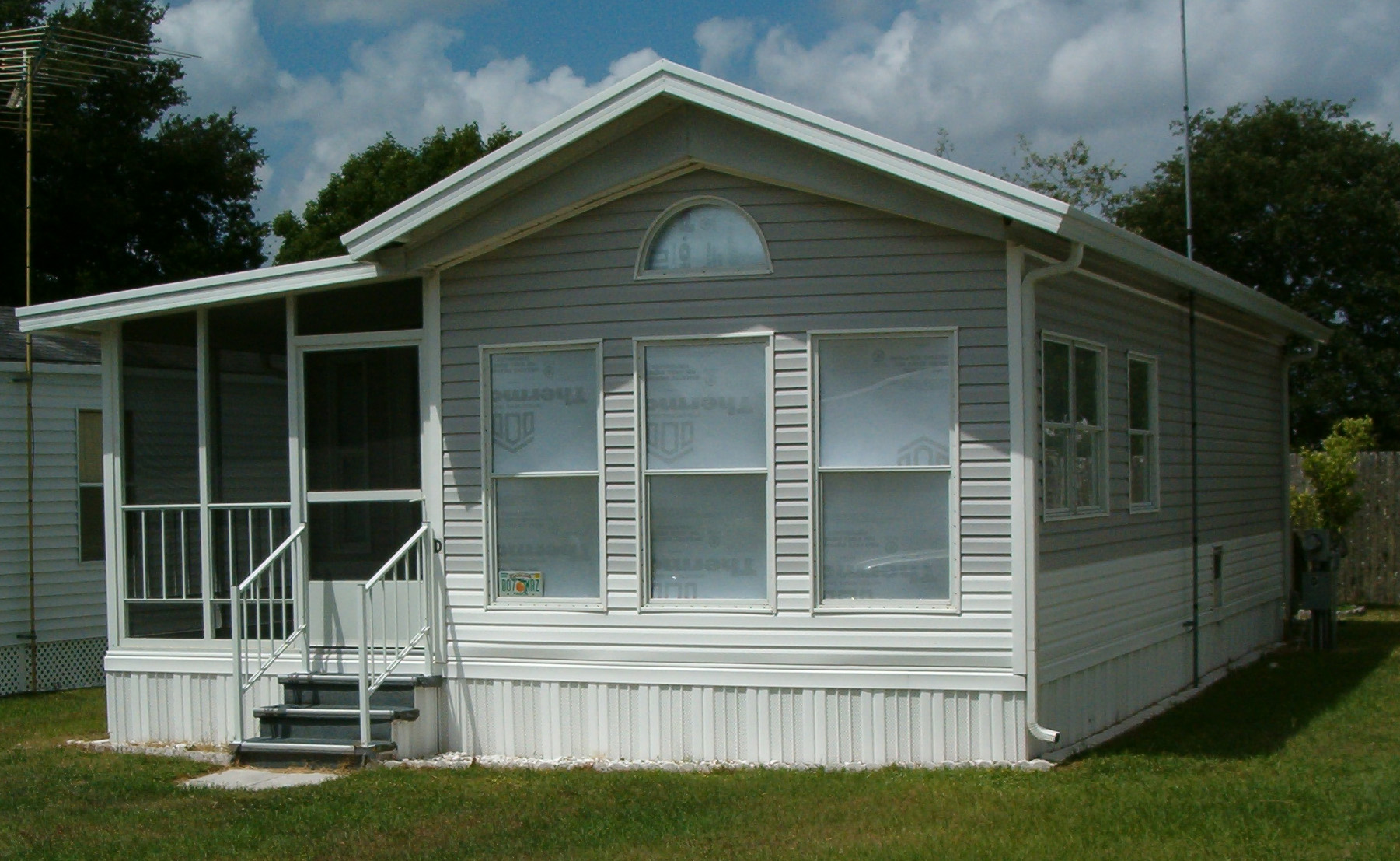
Mobile Homes are a type of the manufactured style. They are can be situated on a private lots, or in a mobile home park. They used to be called "trailer" homes, but cause of their long, narrow appearance which made it easier to move, but today they are getting build in more traditional styles while still retaining the long and narrow look.

Mobile Homes are a type of the manufactured style. They are can be situated on a private lots, or in a mobile home park. They used to be called "trailer" homes, but cause of their long, narrow appearance which made it easier to move, but today they are getting build in more traditional styles while still retaining the long and narrow look.
Duplex

A duplex consists of two housing unite connected in one building. Sometimes they are adjacent to one another, but can also be stacked on top of each other. They are also know as double house, double-Decker, twin house, or a two-family house. They take up less land and are cheaper to build than two separate houses which is what makes them popular. This is a building type, not a style, so it can be build in any sort of style.

A duplex consists of two housing unite connected in one building. Sometimes they are adjacent to one another, but can also be stacked on top of each other. They are also know as double house, double-Decker, twin house, or a two-family house. They take up less land and are cheaper to build than two separate houses which is what makes them popular. This is a building type, not a style, so it can be build in any sort of style.
Neo-Eclectic

This is one of the most commonly built styles today. It is a contemporary home that mixes and matches different elements of the Tudor, Victorian, and colonial styles. The most popular thing seen on this style is Palladian windows. Also, they often have Queen Anne-style gables, and a front porch.

This is one of the most commonly built styles today. It is a contemporary home that mixes and matches different elements of the Tudor, Victorian, and colonial styles. The most popular thing seen on this style is Palladian windows. Also, they often have Queen Anne-style gables, and a front porch.
High Rise Apartment

Three or more housing units joined together is usually called apartments. High rise apartments are six (or more) units stacked horizontally one on top of another. These are built in highly populated areas, to conserve space.
Three or more housing units joined together is usually called apartments. High rise apartments are six (or more) units stacked horizontally one on top of another. These are built in highly populated areas, to conserve space.
Bungalow

Finally, the bungalow (One of my favorite styles, by the way). They were offered by Sear as a mail order house from 1911 to 1920. This style is characterizes by its simplicity, and materials being left as close to their natural state as possible. Each house possessed a front porch, low pitched roof, exposed rafters and braces, and dormers. They often has a gable and/or shed roof. They are very popular in California, and often associated with small town ideas.
So there was have it--the housing styles!

